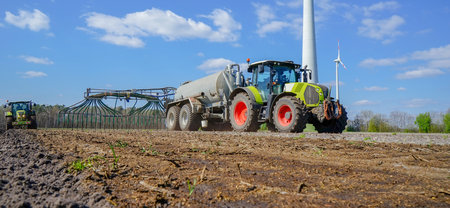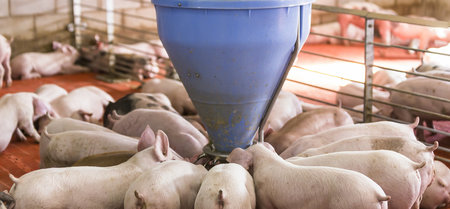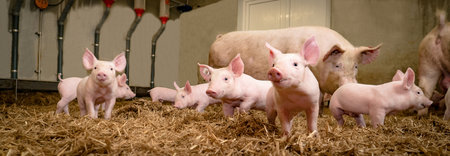
Technical and organisational possibilities to reduce ammonia
Less ammonia in the air makes a decisive contribution to cutting harmful air pollution and reducing nitrogen deposition in sensitive ecosystems. Cost-effective measures to reduce ammonia emissions from agriculture exist and have already been implemented. A number of measures have been documented and evaluated in a series of reports. The choice of measures to be taken at farm level depends on a number of factors. The UN Economic Commission for Europe (UN ECE Task Force on Reactive Nitrogen) Framework Code of Agricultural Practice describes helpful techniques as well as housing and storage systems to reduce ammonia emissions.
1. Improved storage of farm manure
Ammonia emissions from slurry can be cut by reducing the exposed surface area of slurry or other liquid manure in storage. Possible measures:
- Covering of slurry pits and silos with a roof, a floating cover, floating bodies (plastic, straw or bark) or a naturally forming floating cover
- Reduction of slurry channels
- Cooler outdoor storage instead of underfloor storage of liquid manure
Solid manure should be stored as dry and as covered as possible. A small surface area of the solid manure stack, e.g. through a side wall, also helps to reduce ammonia emissions.
2. Low-emission techniques for spreading farm manure
It is very important to minimise nitrogen losses during fertilisation in the field so that the ammonia that was previously prevented from volatilising in the barn or during storage is not lost here. Emission-reducing application techniques cover the slurry with soil directly at or immediately after application, or reduce the exposed surface of the fertiliser. These techniques include:
- Drag hose or drag shoe method
- Injection method, e.g. cultivator
- Immediate incorporation; up to 90 percent ammonia losses can be avoided if the manure is incorporated within a few minutes. The reduction in emissions for training within 4 hours is only estimated at up to 65 percent.
- Dilution of slurry by at least 50 percent at low temperatures, e.g. via irrigation systems

3. Acidification of slurry
Farm fertilizer usually has a higher pH value and is alkaline. By acidifying the slurry to a neutral level or to a pH value of 6, the outgassing of ammonia is reduced by at least 50 percent. This is achieved in conventional agriculture by adding sulphuric acid. A process for the automatic addition of sulphuric acid during application is already on the market and is used throughout Denmark.
The procedure must at all times take care to avoid any risk to personnel, animals and the environment. The efficiency increases the sooner the acid is added. Acidification in the barn is therefore widely discussed in Germany.
4. Strategies for the feeding of farm animals
In ruminants, protein surpluses and N excretion depend heavily on the crude protein content of the feed. The feed composition and feed management thus have a strong influence on the resulting ammonia emissions per livestock unit or per production unit (e.g. 1 l milk). If it is ensured that farm animals are not fed with more protein than is necessary to achieve the desired performance level, N excretion can be reduced. The reduction of emissions per production unit requires good animal husbandry to ensure optimum feed utilisation. Animal genetics, living conditions and animal care knowledge are prerequisites for good animal health.
The following feeding methods help to reduce ammonia emissions.
- The use of lowprotein raw materials
- Reducing the excess in protein supply by adhering to the latest feeding recommendations
- Better adaptation of the feed composition to the needs of the farm animal, e.g. according to lactation stage, age and weight of the animals.
- Increasing the cow's life performance by increasing the number of lactations reduces ammonia emissions per milk production unit

5. Limitation of ammonia emissions when using mineral N-fertilizers
Ammonia losses from ammonium nitrate (NH4NO3) are generally only in the range of 0.5 % to 5 % of the total nitrogen applied. Ammonium nitrate therefore has an advantage over other mineral fertilizers. Ammonium phosphate, ammonium sulphate, urea and urea ammonium N can have much higher losses and thus emissions. According to the German fertiliser ordinance (amendment 2017), urea fertilisers must be provided with a urease inhibitor which prevents the formation of ammonia. Alternatively, these can also be incorporated or injected immediately. In general, field irrigation following fertilisation helps to "wash" the fertiliser into the soil and prevent nitrogen losses.
6. Optimisation of operational nitrogen management
Fertilisation recommendations based on soil and plant analyses provide guide values for assessing the nutrient requirements of arable crops and grassland. In this way, overfertilisation, which would lead to emissions, can be avoided. The farm gate balance is the difference of all nitrogen inputs to the farm (fertiliser, feed, litter, animals, as well as N fixation by legumes and atmospheric N deposition) minus the total nitrogen removal in products (plants, animals, manure) leaving the farm. Since 2018, the material flow or yard gate balance has applied to all farms with more than 30 ha of usable area if their animal stocking exceeds 2.5 GV/ha or if they have more than 2,000 pig fattening places.


